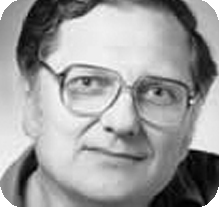
A.M. TURING AWARD WINNERS BY...
William (“Velvel”) Morton Kahan

United States – 1989
Short Annotated Bibliography
For a researcher of his caliber, Kahan has published relatively few journal and conference papers. He found more satisfaction in doing work than publishing it, and was often happy to circulate ideas informally. The unpublished papers and lecture notes on his University of California, Berkeley website are often highly polished and intended for a broad audience.
- Golub, Gene and William M. Kahan, "Calculating the singular values and pseudo-inverse of a matrix," Journal of the Society for Industrial and Applied Mathematics, Series B: Numerical. Analysis, Vol. 2, 1965, pp. 205–224. This paper laid the groundwork for practical application of Singular Value Decomposition (SVD), now a widely used approach to factorizing matrices with applications in statistical analysis and technical computation. It is considered one of the most important papers in the history of numerical analysis. Gene Golub, Kahan’s coauthor and an eminent professor at Stanford University, obtained the PROF SVD license plate to celebrate its impact.
- Kahan, William, “Pracniques: Further remarks on reducing truncation errors,” Communications of the ACM, Vol. 8, Num 1, January 1965, p. 40. Kahan prides himself on his hands-on knowledge of the issues involved in programming scientific computations and in producing software tools to help with this task. This widely cited little item is an example of his dissemination of what the ACM then called a “pracnique” or “practical technique” in one of his central areas of expertise: errors introduced by the rounding of floating point results.
- Kahan, William and J. Palmer, “On a proposed floating-point standard,” ACM SIGNUM Newsletter, Vol. 14, Num. 2, October 1979, pp. 13-21. During the 1970s the ACM's Special Interest Group on Numerical Mathematics (SIGNUM) was a leading forum for the discussion of mathematical software. It published a series of drafts, position papers and discussion items related to the emerging floating point standard. This influential statement made the case for Kahan's approach.
- William Kahan, “Mathematics Written in Sand,” Proceedings of the Joint Statistical Meeting. of the American Statistical Association, 1983, pp. 12-26. Focused in large part on the pocket calculators and spreadsheets of the era, this is an example of the kind of clearly written advocacy paper that Kahan wrote for decades to mock the deficiencies of floating point arithmetic in popular products and advocate for better implementations. This one provides direct insight into the problems the IEEE standard was designed to address.
- Demmel, James and William M. Kahan, "Accurate singular values of bidiagonal matrices," SIAM Journal on Scientific and Statistical Computing, Vol. 11, Num. 5, September 1990, pp. 873-912. Demmel was one of Kahan’s doctoral students, and is also a professor at Berkeley. This paper, further developing the application of singular value decomposition with a new algorithm, won them the SIAM SIAG Prize on Linear Algebra the following year.
-
Kahan William, The John von Neumann lecture: The baleful effect of computer languages and benchmarks upon applied mathematics, physics and chemistry, 45th Annual Meeting of SIAM, Stanford University, 15 July 1997, http://www.cs.berkeley.edu/~wkahan/SIAMjvnl.pdf Many of computing’s most distinguished researchers use their Turing Award Lectures to present their key ideas in accessible form to a broad audience. Kahan never got around to publishing his. However, he also won the corresponding award from the Society for Industrial and Applied Mathematics, and his John von Neumann lecture has been published online. The lecture takes on the deficiencies of some popular languages and methods, pleads the case for the continuing relevance of the IEEE 754 standard’s more commonly neglected features, and calls for the development of new benchmarks to measure accuracy as well as speed.




























 THE A.M. TURING AWARD
THE A.M. TURING AWARD